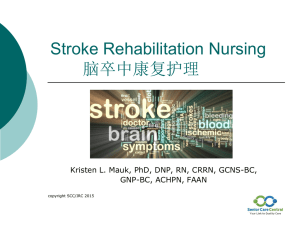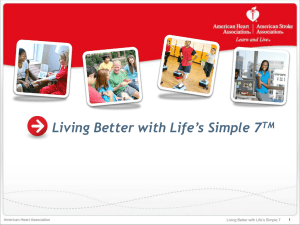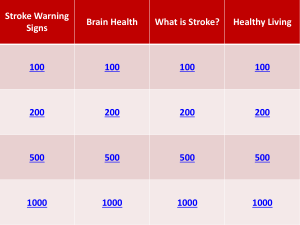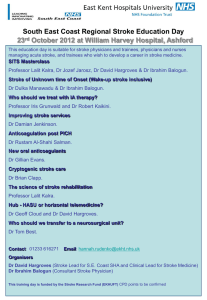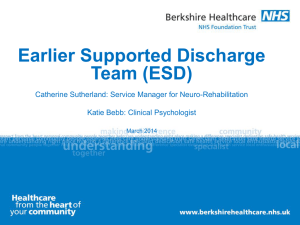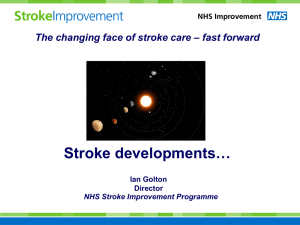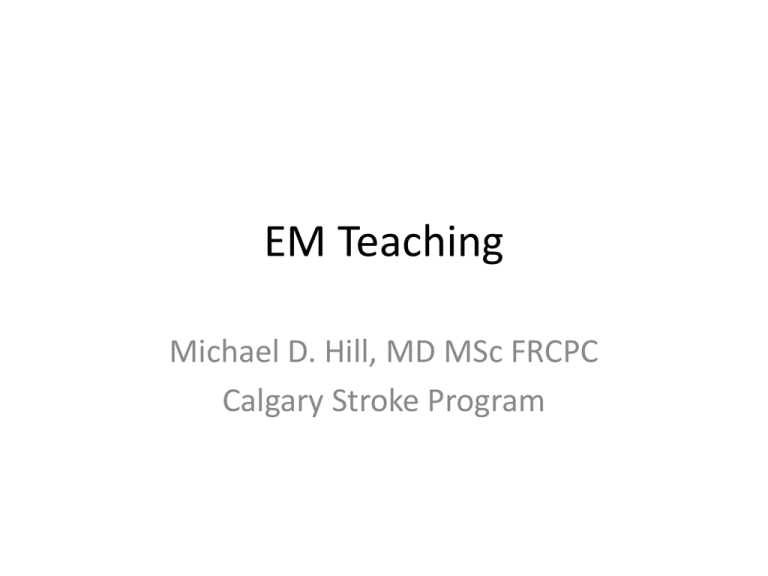
EM Teaching
Michael D. Hill, MD MSc FRCPC
Calgary Stroke Program
Alcohol Warning Labels
If the government really wants to help they should put useful warning labels on products. For
instance alcohol should come with labels warning consumers of these unintended side effects:
1.The consumption of alcohol may make you think you are whispering when you are not.
2.The consumption of alcohol is a major factor in dancing like a retard.
3.The consumption of alcohol may cause you to tell your friends over and over again that you love them.
4.The consumption of alcohol may cause you to think you can sing.
5.The consumption of alcohol may lead you to believe that ex-lovers are really dying for you to telephone them at
four in the morning
6.The consumption of alcohol may make you think you can logically converse with other members of the opposite
sex without spitting
7.The consumption of alcohol may make you think you have mystical Kung Fu powers, resulting in you getting your
ass kicked
8.The consumption of alcohol may cause you to roll over in the morning and see something really scary.
9.The consumption of alcohol is the leading cause of inexplicable rug burns on the forehead.
10.The consumption of alcohol may create the illusion that you are tougher, smarter, faster and better looking than
most people.
11.The consumption of alcohol may lead you to believe you are invisible.
12.The consumption of alcohol may lead you to think people are laughing WITH you.
13.The consumption of alcohol may cause a disturbance in the time-space continuum, whereby gaps of time may
seem to literally disappear.
What is a stroke? (Important slide #1)
Stroke is a syndrome with
multiple possible underlying
etiologies. Stroke is a
sudden vascular problem in
the brain.
Stroke Types
• AIS – Acute Ischemic Stroke and TIA – Transient
Ischemic Attack (85%)
–
–
–
–
Large vessel disease
Cardioembolic
Lacunar
Other
• ICH – Intracerebral hemorrhage (7-8%)
– Lobar
– Deep
• SAH – Sub-arachnoid hemorrhage (7-8%)
• Sinovenous thrombosis (<<1%)
– Large sinus
– Cortical vein
Cause of Death Worldwide
World
Deaths x 10^6
% deaths
Coronary heart dx
7.20
12.2
Stroke
5.71
9.7
Lower resp infections
4.18
7.1
COPD
3.02
5.1
Diarrhoeal diseases
2.16
3.7
HIV/AIDS
2.04
3.5
Tuberculosis
1.46
2.5
Pulmonary cancers
1.32
2.3
MVA
2.27
2.2
Prematurity/LBW
1.18
2.0
Clinical Syndromes and
Pathophysiology of Stroke
Michael D. Hill, MD, MSc, FRCPC
Associate Professor
University of Calgary
Director, Stroke Unit
Staff, Foothills Medical Centre
Calgary, Alberta
Learning Objectives
After reviewing this presentation, you will be
better able to:
1. Understand that stroke is a syndrome consisting of
multiple etiologies
2. Understand mechanisms of ischemia
3. Understand the pathophysiology of cardioembolic stroke
4. Understand mechanisms of intra-cranial cerebral
atherosclerosis
7 of 39
Stroke is a Syndrome
• Stroke (“apoplexy”)
– From the Greek – “to cripple
by a stroke”
– A sudden vascular event
leading to focal neurological
dysfunction
– The clinical presentation
alone does not allow
differentiation between
hemorrhage or ischemia
8 of 39
Stroke Types
• Ischemia [85% of all stroke]
– Transient ischemic attack
• “mini-stroke”
– Acute ischemic stroke
• Intracerebral hemorrhage (ICH) [7-8% of stroke]
• Sub-arachnoid hemorrhage (SAH) [7-8% of
stroke]
9 of 39
Mechanisms of Ischemia
• Ischemia lack of blood flow resulting in tissue
deprivation of nutrients
• The brain can tolerate hypoxia for many tens of
minutes or hours; the brain does not tolerate
ischemia for more than a few minutes
10 of 39
Brain Ischemia
Collateral Flow
Thrombus
11 of 39
Thresholds of Blood Flow leading to
Infarction
CBF pml/100g/min
60
Normal
Oligaemic
35
Electrocortical function
affected
Ionic pump failure
Electrical failure
20
15
10
Cell death
12 of 39
Cerebral Ischemia and Time
CBF (ml/100g brain)
Normal flow, normal function
50
Low flow, raised O2 extraction, normal function
20
Reversible
reduced
function
Irreversible
reduced
function
0
Time
13 of 39
Cerebral Ischemia
• Plumbing problem
• Blocked artery in the
brain
14 of 39
TIA vs. Stroke
• TIA stroke where all symptoms have resolved
within 24h (WHO definition)
• Recent call for modified definition using 1 hour
as the time point and modified by MR findings.
• Ischemic Stroke residual findings after 24
hours, however minor
N Engl J Med 2002: 347(21): 1713-1720
15 of 39
“TIA”
16 of 39
Mechanism of Ischemic Stroke
• Classification
•
•
•
•
•
•
•
Large Artery
Cardioembolic
Lacunar/small artery
Other known cause
Two or more causes
Cryptogenic
Unknown
Ann Neurol 2005;58:688–697
17 of 39
Large Artery Stroke (20%)
• Arteroembolic Stroke
– Thrombus in carotid or vertebral artery on an
atherosclerotic plaque which embolises to the brain –
arteroembolic event – COMMON
– Thrombus on an intracranial arterial stenosis (akin to
an acute coronary syndrome) – UNCOMMON
18 of 39
Pathophysiology of Stable and
Unstable Plaques
Unstable plaque
Thin fibrous cap
Thrombus
Thick fibrous cap
Smooth muscle
cells
Lipid rich core
and
macrophages
Media
Stable plaque
19 of 39
Cardioembolic Stroke (25-30%)
• Proximal embolic event
– Cardiac source
•
•
•
•
Atrial fibrillation/flutter
Valvular heart disease (eg. endocarditis, prosthetic valve)
Post-MI mural thrombus
Proximal aortic atheromatous disease causing arteroembolic
stroke (most often classified in the cardioembolic group even
though large artery disease is the true mechanism)
• Paradoxical embolus via RL intra-cardiac shunt as seen in
large PFO with atrial septal aneurysm
• A thrombus breaks off and embolises to a brain
artery blocking an intracranial artery
20 of 39
Lacunar Stroke (25%)
• Small vessel disease
– Occlusion of small, deep end-arteries
– Associated strongly with hypertension and diabetes
mellitus
– Mechanisms are:
• Lipohyalinosis with arterial wall collapse
• Microatheroma with in situ thrombus
• Small embolic material to these penetrating arteries
21 of 39
Other Known Causes (<5%)
• Multiplicity of other
causes:
– Dissection
– Metabolic stroke
• Fabry’s disease
• MELAS
• Hypercoagulable states
(eg. essential
thrombocytosis)
55 yo woman with a dissected ICA seen here on angiogram
22 of 39
Cryptogenic (20%)
• Despite complete and thorough investigation,
the cause of stroke is unknown
– Commoner in younger patients
– ~20% of patients will have no cause identified
23 of 39
Pathology of Stroke Mechanism
• Atherosclerosis
– Relevant directly to about 20% of strokes – the large
artery strokes
– In these patients, the analogy to coronary artery
disease is direct
– Typical risk factors contribute to cerebral
atherosclerosis – elevated lipids, smoking,
hypertension, diabetes mellitus
24 of 39
Intra-cranial Cerebral
Atherosclerosis
• Intracranial atherosclerosis is uncommon in
western populations; greater prevalence in Asia
• When present in Caucasians it is most often
seen in diabetics who smoke
25 of 39
Pathology: Cardioembolic Stroke
• Commonest cardioembolic source in the
western world is atrial fibrillation
– Hypertension as risk factor
– Heart failure (most often due to CAD) as a risk factor
• Thus, indirectly atherosclerosis of the coronary
arteries has an effect on stroke via the heart
26 of 39
Cardioembolic Stroke
• Multiple other causes of
cardioembolic stroke
– Infective endocarditis – blood cultures
and ESR should be done acutely on all
patients with fever at stroke onset
– Marantic endocarditis
– Rheumatic heart disease
TTE showing atrial myxoma
– Mitral stenosis
– Mural thrombus due to MI, dilated
cardiomyopathy
– Cardiac tumours (atrial myxoma,
fibroelastoma)
27 of 39
Cardioembolic Stroke
• Mitral valve prolapse not a risk factor for
stroke
• Mitral annual calcification weakly associated
with stroke
28 of 39
Pathology Lacunar Stroke
• Small artery disease lacunar stroke
• End arteries
• Susceptible to occlusion due to lipohyalinosis of
the relatively thin muscular arterial layer
• Embolism (arteroembolism, cardioembolism) to
the perforating arteries is known to occur but is
less common a cause of lacunar stroke
29 of 39
Other Causes of Stroke
• Dissection
– Tear in the intima of the artery wall
– Most commonly spontaneous
– Associated with trauma in some cases
– May be iatrogenic due to endovascular treatment
– May occur in vertebral or carotid artery systems; 15%
of the time dissection occurs in two or more arteries
concurrently
N Engl J Med 2001: 344 (12): 898-906
30 of 39
Other Causes:
Hypercoagulable States
• Myeloproliferative disorders :
– essential thrombocytosis, polycythemia rubra vera,
CML
• Antiphospholipid Antibody syndrome
• Genetic deficiencies (eg. AT3, protein C, S, APC
resistance, prothrombin and factor XII mutations)
are not a direct cause of arterial ischemic stroke.
They may be relevant in paradoxical embolus
due to their well-defined role in venous
thromboembolism.
31 of 39
Other Causes: Vasculitis
• Intracranial cerebral vasculitis
– Idiopathic granulomatous angiitis of the CNS
– Amyloid angiopathy vasculitis
– Systemic angiitis affecting the CNS
• Lympomatoid granulomatosis
• Wegener’s
• PAN
• Distinguish from segmental vasospasm
induced by drugs, blood
32 of 39
Key Concept: Determining Ischemic
Stroke Mechanism
• Stroke mechanism is determined by inference based
upon investigations completed after the fact
– Eg. atrial fibrillation with normal carotid arteries
infer that the mechanism is cardioembolic
• Only about 20% of stroke is akin to coronary artery
disease – ie. large artery
• The term atherothrombotic stroke is not a useful way
to think about the cause of stroke because
atherosclerosis is only relevant in a minority of
ischemic stroke
33 of 39
ICH Type
• Anatomic
Classification
– Lobar
• Superficial hemorrhage
extending to the cortical
surface
– Sub-cortical
•
•
•
•
Basal ganglia
Thalamus
Dentate
Pontine
34 of 39
Mechanism of ICH
• Mechanistic classification
– Primary (=spontaneous,
idiopathic)
• Amyloid angiopathy
• Hypertensive hemorrhage
– Secondary
• AVM
• Cavernoma (venous angioma)
• Tumour
• Coagulopathy-associated
• Sympathomimetic drug-related
(eg. cocaine, pseudoephedrine)
• Vasculitis
• Iatrogenic
• Traumatic
Typical deep hypertensive hemorrhage in the putamen
35 of 39
Massive ICH: > 200 cc
36 of 39
Mechanisms of SAH
• SAH – the most common cause is blunt trauma
to the head
• Usually, when we discuss SAH, we are speaking
of atraumatic SAH
• Cause rupture of an aneurysm of a proximal
intracranial artery, usually at the circle Willis
(“Berry Aneurysm”)
N Engl J Med 2006;354:387-96
37 of 39
SAH
• Atraumatic SAH
– Angiogram negative ~15% of the time (no aneurysm
or arterial abnormality)
• Perimesencepalic may be the commonest angionegative SAH
• Superficial cortical SAH may occur secondary to:
– amyloid angiopathy, venous occlusion and ischemic
stroke (with and without thrombolysis). This is a
relatively rare phenomenon.
• Angiography may be negative and repeat studies may
show a ruptured aneurysm
38 of 39
Angiogram Negative SAH
39 of 39
ADDITIONAL RESOURCE SLIDES
40 of 39
Multiple Causes of Ischemic Stroke
Large Artery Disease
Small Vessel Disease
Cardioembolic Disease
Other or No Cause Found
Stroke 2001;32:2735
Neurology 1994;44:626
41 of 39
Small Vessel Arteriosclerosis – Hypertension
Occlusion
Leakage
Lacunar
stroke
ICH
42 of 39
Noncardioembolic Stroke Causes
Large Artery Disease
Small Vessel Disease
Other or No Cause Found
Stroke 2001;32:2735
Neurology 1994;44:626
43 of 39
Agenda
1) We best learn from our mistakes, and I have had a few of them! A few
cases of where the ED md's could have done a better job is always of high
interest to residents and ED staff.
2) Risk stratification is always on the top of our minds as we see people
presenting with a miriad of symptoms and we can always get better at risk
stratifying.
3) Stroke mimics and how to differentiate these from the real deal.
4) Basilar stroke presentations and how to identify them, especially when
there are bilateral symptoms. A second to that, a discussion on bilateral
findings and when they are not worrying and when they are not.
5) Up and coming stroke therapies and protocols.
Risk Stratification
• Prognosis exercise
• Distinguish clearly between:
– Prognostic factors
– Effect modifying factors
Risk Stratification: Therapy and
disposition
• Is an acute intervention warranted?
• What is the correct disposition of my patient?
– Discharge home?
– Outpatient clinic? If so, when?
– Admit –ie. consult
Risk Stratification: Therapy and
disposition
• Thrombolysis
• BP treatment
– ICH
– AIS / TIA
– SAH
• Antithrombotic therapy (ASA, heparin)
• TIA / minor stroke stratification
CT – 4.5h into stroke
77yo man,
tourist visiting
Banff
~4h into his
stroke
Intubated,
coma, L
hemiplegia
CTA-SI
-not salvageable
-palliated
Stroke Mimics: Diagnosing Stroke
Michael “give the juice” Hill, MD MSc FRCPC
a “get on with it” production
by “I like the smell of tPA in the morning” studio
50
Stroke Mimics
1.
2.
3.
4.
Migrainous phenomena
Somatization
Seizure
Old stroke with emergent symptoms
Less commonly:
5. Space occupying lesion – subdural, glioma, metastasis
6. Metabolic toxic – hypoglycemia, alcohol, drugs
7. Other stroke type – SAH
8. Local – hip #, brachial or sup fem artery occlusion
51
Cases
54 yo man presents with -history of sudden collapse but no witness and so
the etiology and timing is uncertain
-awake, alert, mute, staring
-eyes straight ahead (no gaze deviation)
-plegic L side
Discussion?
52
Case
25 yo woman
-visiting from New Zealand
-presents with sudden onset diplopia, headache,
neck stiffness, dysphagia, inability to move the
tongue
-awake, alert, distraught affect, moves all limbs
actively against gravity
-agitated, hard to get consistent exam, possibly
ataxic in all four limbs, unable to walk
Thoughts?
53
Case
75 yo woman
-visiting a friend in hospital
-on way out of the hospital going to her car, she
collapses, can’t get up
-witnessed; brought to ER within 20 min
-awake and alert, speaking normally, no evident
hemispatial neglect
-cannot move L leg
Thoughts?
54
Pitfalls
Age of patient
Take a social history
Examine the patient
Remember –
Most people will present with an unusual
presentation of a common disease rather than an
unusual disease (with a common or uncommon
presentation). [Corollary of Occam’s razor but of course, Occam
died of multiple causes]
55
Stroke Mimics in
the ER
Saturday Morning Workshops
Learning Objectives:
1. To review the other conditions that present
like acute ischemic stroke (mimics)
2. To have a bedside strategy to quickly and
efficiently rule out these stroke “mimics”
a. To avoid incorrectly over-treating a stroke mimic
b. To avoid delays in correctly treating true acute
ischemic strokes and stroke mimics
The Challenge !
Stroke is often initially a clinical diagnosis aided by a
standard imaging modality that has limitations
There is a better imaging modality but it has its own
limitations (mainly availability)
There is overlap in the signs of true stroke and stroke
mimics
There is a treatment for true stroke that has constraints
(time) and risks (hemorrhage)
10. What is the risk of thrombolyzing
a stroke mimic?
True stroke
(n = 243)
3 (1.2 %)
Stroke mimics
(n = 7)
0
Symptomatic
ICH
13 (5.3%)
0
Asymptomatic
ICH
30 (12.3 %)
0
Angioedema
Thrombolysis in Stroke Mimics. Stroke 2009
Misdiagnosis of Stroke in TPA Treated Patients.
Ann Emerg Med 2003.
66 yr female brought to
ER by husband
Sudden onset (~ 2 hrs ago) of slurred speech, right facial droop, and
right arm weakness
Headache & mild nausea earlier in the day; c/o “chills”
Hx of hypertension; remote hx of complex migraine; moderate
Alzheimer’s
On ASA, amlodipine, donepezil
BP = 173/94 HR = irreg (80 - 120) RR = 20
T = 38.2
PERL, normal EOM (but eyes favor the left), no carotid bruits
Right lower facial droop (UMN)
3/5 strength right arm, 4/5 strength right leg
Speech slurred and slightly confused
1. What should be done immediately
next?
a. Complete & comprehensive neurological
examination
b. Administration of 160 mg acetylsalicylic acid
(ASA)
c. Blood glucose & SaO2
d. CT scan
e. ECG
5th & 6th VITAL SIGNS:
2. What is going on here?
a.
b.
c.
d.
e.
Ischemic stroke
Subarachnoid hemorrhage
Stroke mimic
Stroke chameleon
Any of the above
3. What is the difference between a
stroke & a stroke mimic?
Stroke ~ sudden onset of a focal neurological
deficit in a recognizable intracranial vascular
distribution resulting in a common clinical
syndrome due to vascular occlusion or
hemorrhage
Stroke mimic ~ a nonvascular condition that
may simulate stroke
4. What are some common stroke mimics?
METABOLIC / SYSTEMIC CONDITIONS:
Hypoglycemia / hyperglycemia
Hepatic encephalopathy
Hypertensive encephalopathy
CNS CONDITIONS:
Post-ictal state with focal neurological signs (Todd’s paresis)
Nonconvulsive status epilepticus
Hemiplegic migraine
Subdural hematoma
Brain abscess
Intracranial tumour (primary / metastatic)
Multiple sclerosis
PSYCHIATRIC CONDITIONS:
Conversion disorder
Factitious disorder
5. How common are stroke mimics?
a.
b.
c.
d.
e.
9%
4%
13%
1.2%
All of the above
Huff. Emerg Med Clin N Am. 2002
Norris
Libman
Kothari
Alder
Ay
(1982)
(1995)
(1995)
(1999)
(1999)
When was
diagnosis
made?
At stroke unit
admission
After initial
ED
assessment
At admission
from ED
Within 6 hrs
of onset
Unclear
Who
diagnosed the
stroke?
Intern, family
physician,
neurology
resident
Emergency
physician
Emergency
physician
Unclear;
likely
neurologists
Neurologists
What studies
were done to
arrive at the
diagnosis?
History,
physical
History,
physical
History,
physical,
labs, CT
Unclear
CT, labs
Multiple, few
CTs
Some CTs
Unclear
MRI, MRA,
DMI, PMI
MRI, DMI
13%
19%
4%
9%
1.2%
Were other
studies
eventually
performed?
How many
stroke mimics
were there?
6. What features suggest that this is a stroke?
Age?
Risk factors?
Current BP? Irregular heart rate?
Recognizable vascular distribution / clinical pattern?
7. What features suggest that this is a mimic?
Headache & nausea?
Chills & fever?
Migraine history?
Workshop title?
Incidence of Stroke Mimics by Age
Groups. J Stroke Cerebrovasc Dis 2008.
Nearly 1/3 of older patients with true stroke had features
of stroke mimic
Hand et al. The Brain Attack Study. Stroke 2006;37:769
Prospective observational study, single center, N = 350
Univariate analysis = 47 parameters
FAVORING MIMIC:
Hx of cognitive impairment
Confusion, loss of consciousness, seizure at onset
No neurological signs, signs that do not lateralize/localize, or signs that do
not fit a vascular territory or clinical syndrome
Abnormal findings in other systems
FAVORING STROKE:
Hx of CAD or PVD
Exact time of onset
Definite lateralizing /localizing neurological symptoms, demonstrable
neurological signs
Signs consistent with clinical stroke syndrome
The Brain Attack Study. Stroke 2006
Recognition of Stroke
in the Emergency
Room (ROSIER).
Lancet Neurol 2005
FAVORING MIMIC:
FAVORING STROKE:
Confusion
Loss of consciousness
Seizure at onset
No neurological signs
Signs that do not
lateralize
Signs that do not fit a
vascular territory or
clinical syndrome
Signs in other systems
CVD history
IHD, PVD
Exact time of onset
Definite neurological
symptoms
Demonstrable
neurological signs
Signs consistent with
clinical stroke syndrome
Glucose = 6.6
Normal routine chemistry
Platelets = 455
INR = 1.2
ECG = atrial fibrillation
Prior to CT she vomits once & receives 10 mg IV
metoclopramide
On return from CT her neurological symptoms are
rapidly improving
CT is normal
Subsequent MRI & MRA is normal
Migraine Equivalent:
Migraine without pain (5%)
AKA migraine variant
Prolonged aura (can be atypical)
Focal neurological signs
ICHD-2 (2004)
Hemiplegic migraine
Opthalmoplegic migraine
Retinal migraine
Vertiginous migraine
Acute confusional migraine
8. How long can hemiplegic migraine
last?
a.
b.
c.
d.
e.
Less than 1 hr
Less than 4.5 hrs
Less than 24 hrs
Less than 72 hrs
More than 72 hrs
9. What is the longest hemiplegic migraine
reported on the internet?
77 days
Summary (cont’d):
Differentiation of some can be difficult
Consult liberally
Where feasible MR can be diagnostic
Neurologist on-call
Radiologist on-call
52 yr male
EMS Report:
Found on floor in restaurant restroom
Mâitre-d’ recognizes him having walked in alone 50
minutes ago; he was walking and talking “okay”
Waiter reports that he seemed “normal” when he
ordered a drink 30 minutes ago, asked where the
restrooms were, and walked there “like normal”
Incontinent of urine & stool
Wallet – businessman from Alberta; home phone
number ~ no answer; no NOK listed
60
EMS ~ “code-stroke” ~ stroke center bypass
No previous chart; only history is from EMS
BP = 158/84 HR = 100 RR = 12
SaO2 = 98% T = 36.4
Markedly slurred speech; appears confused
PERL, normal EOM (but eyes favor the left)
3/5 strength left arm, 2/5 strength leg
Strong odor of alcohol on his breath
Very large BMI
1. What should be done
immediately next?
a.
b.
c.
d.
e.
Blood glucose
Mobilize staff for CT scan
Venous access
CBC, INR, routine chemistry
All of the above can be done concurrently
2. What is going on here?
a.
b.
c.
d.
Ischemic stroke
Subarachnoid hemorrhage
Stroke mimic
Too many martinis at today’s business
lunch
e. Any of the above
3. What features suggest that this is a mimic?
Confusion?
Incontinence?
Alcohol on breath?
His age?
4. So, is this a mimic?
Glucose = 11.5
Normal routine chemistry
Platelets = 125
INR = 1.1
CT is normal
ECG = minor LV strain
His neuro exam is
unchanged
5. What will you do next?
90
Collateral from local businessman who was to meet
him at restaurant
Just met at conference today
Patient was upset
Brother had recently had a stroke and is bed-ridden
Hated seeing him that way (“better off dead”)
Said he himself was healthy
His neuro exam is unchanged
6. What will you do next?
120
Search of his briefcase (brought by local businessman)
Bottle of pills
His neuro exam is unchanged
7. What might this be & what
will you do next?
145
8. What is Todd’s paresis?
Occurs in up to 13% of seizures
Most common after GM seizures
Mechanism unclear
9. How long can it last?
Usually hours, but rare cases up to several
days
11. Why do both patients look left?
III
III
VI
VI
III
III
VI
Away from a
seizure . . .
VI
III
III
VI
Towards a
stroke . . .
VI
A few more
mimics not to
miss . . . what
are these?
Any questions????
Summary:
Stroke mimics occur in 2 – 20% of acute neurologic
deficits
Most commonly hypoglycemia, migraine equivalent,
Todd’s paresis
Most others will be diagnosed by imaging & labs
Most important is to efficiently identify those with true
strokes who may benefit from thrombolytic therapy
Approach to Coma


